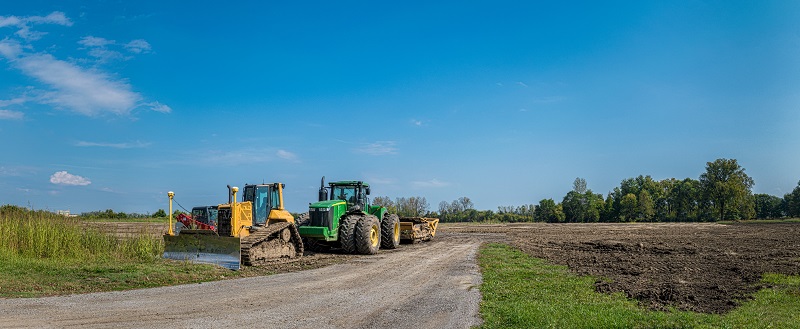Is it Time to Reconsider the Decision to Buy or Lease Equipment?
By Michael Jacobson
Given the historically low interest rate environment in which we find ourselves, most business owners in capital intensive industries will be impelled to explore their options when it comes to obtaining new equipment. Whether it’s best to use lease financing or purchase equipment outright depends on multiple factors including (but not limited to) the type of company and their competitors, industry performance, and the probability of a business sale in the coming years. As a general proposition, lower interest rates have a positive macroeconomic impact because they spur capital spending and economic growth1. As companies work to keep up with increased economic demand, they may face capacity constraints and may need to consider adding equipment. Whether they decide to obtain new equipment through a leasing arrangement or to purchase it outright, it’s imperative that company owners consider future plans for their business in their decision making. If a potential sale is part of those plans, then the manner used to purchase new equipment today can potentially have an impact on business value in the future.

In most situations involving the sale or transfer of a business, the value of that business needs to be determined in order to make a number of financial and tax-related decisions. For businesses that can reasonably and reliably forecast their cash flows for several years into the future, the typical valuation approaches that are utilized to value the business will often involve the discounted cash flow method (a form of the income approach) and/or applying a valuation multiple to some relevant forward-looking financial metric (a form of the market approach).
But, what about those businesses that aren’t fortunate enough to be able to reliably predict future cash flows?
Tool and die makers and construction companies are just two examples of the types of companies where it is notoriously difficult to accurately forecast long-term future results. These types of companies often face competitive bid situations, suffer from a lack of long-term contracts and are heavily impacted by variable macro-economic factors. For these types of businesses where accurate long-term forecasting is difficult, the historical performance of the business frequently becomes a focal point for potential investors attempting to quantify the future earning potential of the business. Investors are focused on future earnings as part of their investment strategy, and without a reliable forecast, a company’s actual historical performance tends to be considered more heavily. In these instances, the technique that is commonly employed is known as the “capitalized cash flow” or “capitalization of earnings” approach (both are forms of the income approach)2. These methodologies estimate a reasonable level of cash flow or earnings the business is expected to sustain into the future, and then make certain adjustments for estimated capital expenditures, depreciation, and changes in net working capital, to arrive at an estimate of a sustainable amount of annual net cash flow for the business. This forecasted annual cash flow figure is then converted into an estimate of business value through the application of a capitalization rate. Within this type of income approach, determining a supportable, sustainable level of earnings for the business is paramount. Without reliable forecasting, many potential investors will look at the company’s historical free cash flows as a starting point, ensuring that the historical period being analyzed captures any industry cyclicality or adjusting for any abnormalities that may be impacting the financials. Further, another important consideration in these analyses is the appropriate discount rate to apply, as the discount rate should reflect, among other items, industry risk, size of the subject entity relative to competitors, management depth and expertise, geographic diversification, product line diversification, projection risk and financial leverage. The greater the perceived risk associated with the cash flows, the higher the discount rate applied to them and, consequently, the lower the resulting business value. It reasonably follows that a business with consistent, stable, historical earnings is preferable, from an investment standpoint, to one with significant earnings swings, all else being equal.
Why is any of this relevant to the leasing industry?
The reason is that in certain businesses where management has traditionally purchased their equipment outright for cash, it may make strategic sense to revisit whether it is more advantageous to lease the equipment in the current interest rate environment and become potential customers for lessors. Purchasing the equipment outright can involve a significant capital expenditure, which is a reduction to free cash flow. These large capital expenditures can create volatile or “lumpy” cash flows, which can create the perception amongst potential investors that there is more variability (i.e. risk) in achieving the forecasted, sustainable cash flows. Alternatively, leasing the required equipment allows for a constant payment over the life of the lease which, all else being equal, will result in a more consistent level of cash flows. This consistency in historical cash flows can also be helpful during the sale of the business because it can reduce the number of “normalizing adjustments” made during the sell-side due diligence process, and potential investors tend to favor fewer normalizing adjustments. Typically, more consistent and less variable cash flows tend to indicate lower risk to potential investors and can lead to higher firm values, with all other things being equal.
This situation certainly does not apply to all companies; however, it is something to remember because there are approximately 12 million baby boomers who are business owners in the U.S., and 70 percent of them will be retiring over the next couple of decades.3 Combine that with the fact that only about 15 percent of family-owned businesses have a discussed and documented succession plan in place4], and there are a lot of businesses without a defined strategy that are potentially going to be sold to external buyers in the coming years. This translates into the very real possibility of a huge new market of potential lessees looking for help in operating their businesses. For those businesses that have a difficult time preparing accurate and reliable forecasts, and that have the potential to be new equipment leasing clients in the coming years, it may make strategic sense to revisit whether leasing certain pieces of equipment is the more advantageous option, regardless of historical preference.
For more information, or to discuss how the decision to buy outright or lease equipment may impact the ultimate value of your business, please contact our office.
Our team of business valuation experts has deep experience, spanning a wide range of industries. We are here to help you create a well-reasoned strategy for accomplishing your personal and financial goals.
¹ IBISWorld Industry Report 53249, Industrial Equipment Rental & Leasing in the US
² Potential investors may also consider applying a valuation multiple to some relevant historical financial metric; however, the underlying assumption in these cases is typically that the business will continue to operate at that historical level into the future.
³ Wealth Management, “Here Come the Boomer Biz Owners”, Jan 2013
4 Boston Globe, “More than 8 out of 10 family businesses have no succession plans”, February 2016
This article originally appeared in BOD USA, LLP’s “Insights” (August 2019). Copyright © 2019 BDO USA, LLP. All rights reserved. www.bdo.com



